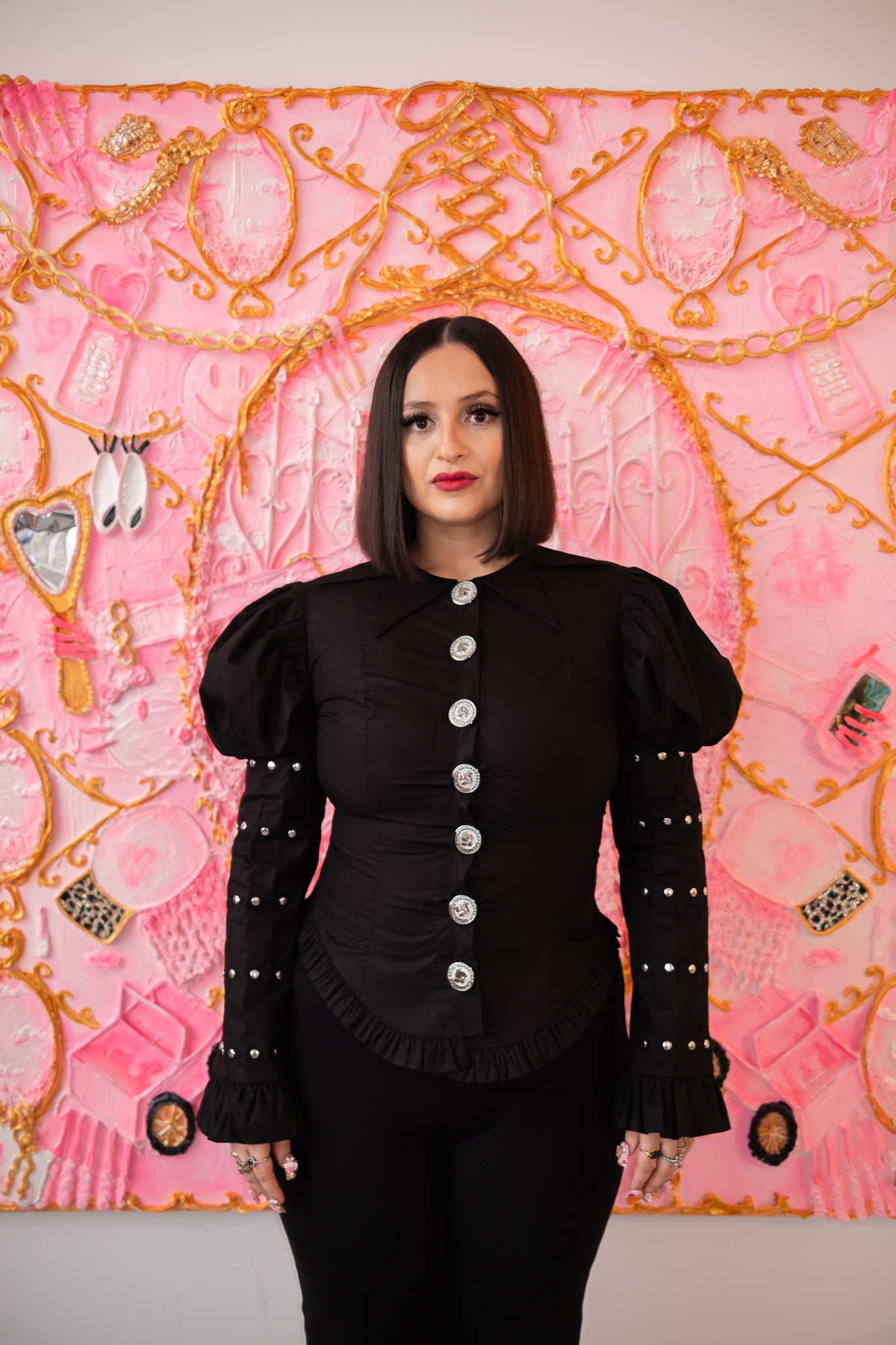
This summer, as Barbie fever took over popular culture, so did the film’s signature brand of pink. Seemingly overnight, the color was everywhere—on runways, red carpets, car insurance commercials, even Burger King buns. The furor ultimately led to a global paint shortage.
The Barbie “moment” came up in a recent conversation with Yvette Mayorga, a Mexican-American painter and sculptor whose work is almost always awash in a similar pink hue. This was not the first time she had been asked about it.
“I think it’s a good beginner introduction to feminism,” Mayorga said of the film, somewhat equivocally, before clarifying that she was left “wanting more of a complicated narrative.”
Installation view of “Yvette Mayorga: Dreaming of You” at the Aldrich Contemporary Art Museum, 2023. Courtesy of the Aldrich.
The artist, who was speaking on the occasion of her new exhibition “Dreaming of You,” at the Aldrich Contemporary Art Museum in Ridgefield, Connecticut, was smart to hedge. For one, Barbie-mania feels, today, less like a marketing campaign built around a movie and more like a movie built around a marketing campaign. (The film’s $150 million marketing budget was indeed bigger than its $145 million production budget.) Barbie may mock the commoditization of gender, but its corporate overlords have exploited it to pull a similar trick.
More importantly, Mayorga’s relationship to pink is a deeply personal one forged well before the film and its attendant consumer craze. The color has been a staple of the artist’s work almost since the beginning of her practice, roughly a dozen years ago. She’s always viewed pink as an “underdog”: oft dismissed for its feminine, kitsch associations, but extra potent for the same reason.
In her world, colors can’t be reduced to stereotypes. Nor can people.
Installation view of “Yvette Mayorga: Dreaming of You” at the Aldrich Contemporary Art Museum, 2023. Courtesy of the Aldrich.
“Dreaming of You” is not Mayorga’s first museum show, but it is effectively her first survey, bringing together pieces from the last six years of her career. The exhibition does more than showcase individual objects. It puts on display the evolution of her practice during that time—a period that saw the artist extend her candy-coated vision beyond the canvas to sculpture, video, and installation.
Naturally, pink is all over the show; most of the museum’s walls have been painted with it. One gallery is entirely cloaked in the color, save for a black-and-white checkerboard floor that feels a little Lewis Carroll, a lot David Lynch.
For Mayorga, pink is a point of entry, luring viewers with its boldness. It’s also a point of departure, evoking the polish of Pop art and the lavishness of the Rococo, as well as the bubblegum, “girl power” aesthetics of her Y2K youth. Her preferred hue is “Mexican pink,” a color with historic cultural roots that has, in more recent times, also become symbolic of the Latinx experience in a divided America.
Yvette Mayorga, ICE ICE LADY (2017). Courtesy of the artist.
Reclaiming the labor of craft, Mayorga often applies her pink acrylic paint with bakery-style piping bags. The strategy is an homage to her mother, who worked as a cake decorator in Chicago’s landmark Marshall Field’s department store upon immigrating to the U.S. in the 1970s. It also lends the artist’s creations the appeal of something frosted and delicious. “When people encounter the work for the first time,” Mayorga explained, “they often say, ‘Wow, I want to eat it’ or ‘I want to touch it,’ ‘I’m craving something sweet.’”
And yet, while Mayorga’s pink artworks look like confections, they taste more like medicine. At the core of almost everything she makes is a theme that underlies them all: the fallacy of the American Dream.
One 2017 painting on view at the Aldrich, for instance, nods to the lavish epicureanism of a Late Baroque masterpiece, but its title conjures an altogether different scene: I Remember Eating Hot Chips when my Dad got Deported, After J.H. Fragonard, “The Swing.” Another work from the same series, called High Maintenance, plays on the dual meanings of the word “ICE,” depicting a woman swimming in a palace while an Immigration and Customs Enforcement agent enters at the edge of the frame.
“I want people to feel disappointed, in a way,” she said of her works’ bait-and-switch play. “Because not everything is what we think it is.”
Installation view of “Yvette Mayorga: Dreaming of You” at the Aldrich Contemporary Art Museum, 2023. Courtesy of the Aldrich.
Among the standouts in “Dreaming of You” is a suite of three new life-sized portraits of her siblings. These form an extension of a body of work she introduced this time last year in a solo show at The Momentary, a satellite branch of the Crystal Bridges Museum of American Art in Bentonville, Arkansas.
The paintings were conceived as a reference to German lithographer Martin Engelbrecht (1684-1756) and his series depicting low- and middle-class laborers. Among Engelbrecht’s subjects are bakers and confectioners, but their jobs, Mayorga pointed out, are “not the defining characteristics of the portraits. You see the people first, then you see these very subtle references to labor.”
Mayorga’s versions are ovular, shaped like mirrors. They have a lot of mirrors embedded in them too: “I thought it was really important for the viewer to be able to see their reflection in the work.” The idea, she continued, is to remind viewers to “[consider] who the person is before tying them to their labor. That’s a really important conversation to have right now, because of the way that Latinx people are perceived. We are not a monolith.”
Yvette Mayorga, Scorpion After Ouvrière en Porcelaine (2023). Courtesy of the artist.
“Yvette Mayorga: Dreaming of You” is on view now through March 17, 2024, at the Aldrich Contemporary Art Museum in Ridgefield, Connecticut.